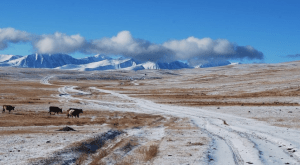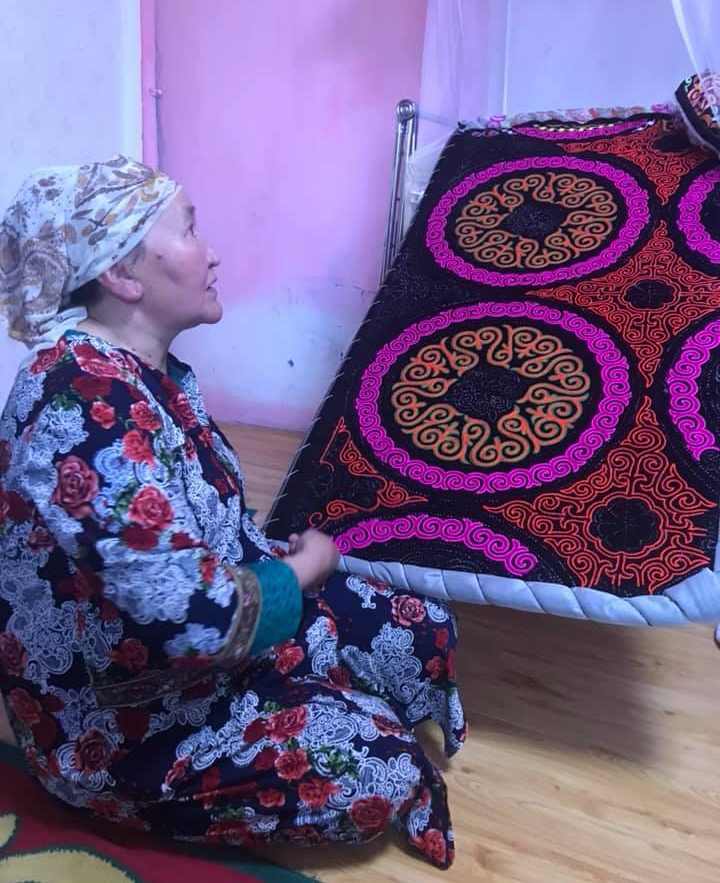Mongolia’s Altai Tavan Bogd National Park – In The Land Of The Gods
Altai Tavan Bogd National Park is one of Mongolia’s most awe-inspiring protected areas. It forms part of the mighty Mongolian Altai Mountains—an extension of the greater Altai range that lies at the confluence of Central Asia and Siberia. This high-altitude region, where peaks soar above 4,000 meters, stretches across Mongolia’s far western provinces of Bayan-Ölgii and Khovd, and marks the rugged borderlands with China and Russia. As the range trails southeast, it gradually softens into the Gobi-Altai Mountains.
The park is a landscape of powerful contrasts—glaciated summits, alpine meadows, high mountain lakes, and sweeping steppe. Ice-fed rivers wind through deep valleys, and the area’s shifting ecosystems support both Kazakh and Tuvan (Uriankhai) herding communities. But it’s not only a place of dramatic natural beauty—it’s also a cradle of human history, with archaeological and cultural sites that date back to the Palaeolithic era. These include traces from the Bronze Age and remnants of powerful nomadic empires like the Hunnu, Turkic, Uighur, and Mongol.
A UNESCO World Heritage Landscape
Located within the national park is one of Mongolia’s UNESCO World Heritage Sites: the Petroglyphic Complexes of the Mongolian Altai. This extraordinary cultural treasure includes three main locations—Tsagaan Salaa-Baga Oigor, Upper Tsagaan Gol, and Aral Tolgoi—each rich in rock art, funerary sites, and ritual monuments. Together, they represent a continuous record of human culture over more than 12,000 years. Read more here.

The Altai Tavan Bogd Mountains
The park’s namesake—the Tavan Bogd or ‘Five Saints’—are Mongolia’s highest peaks. These permanently snow-capped mountains encircle the Potanin Glacier, Mongolia’s longest, and dominate the park’s northwest corner. The five peaks are:
Khuiten Uul (Cold Peak) – Mongolia’s highest at 4,374 meters
Nairamdal (Friendship) – 4,180 meters
Malchin (Herder) – 4,050 meters
Bürged (Eagle) – 4,068 meters
Olgii (Cradle) – 4,050 meters

One of the most rewarding ways to explore Altai Tavan Bogd is on an extended trek. The classic route between the base camp of Khuiten Uul and the remote alpine lakes typically takes between 5 to 10 days, depending on the direction, pace, and chosen mode of travel—on foot, by horse, or even mountain bike.
For those with less time, a shorter journey to and from what’s simply known as Base Camp is also possible. Situated at around 3,100 meters, the camp offers sweeping views of all five sacred peaks. Reaching it usually involves a 10–15 km hike from the nearest ranger station, with the distance depending on your starting point. Most groups rely on camel caravans to carry supplies, allowing for a more relaxed and immersive experience.
Base Camp sits near the edge of the majestic Potanin Glacier—the largest in the Mongolian Altai—spilling from the eastern face of Khuiten Uul and framed by the dramatic backdrop of the ‘Five Holy’ peaks.
Though often shared with other groups, the setting remains humbling. Here, amid towering summits, ancient icefields, and vast silence, the landscape leaves a lasting imprint—wild, remote, and utterly unforgettable.
In this extraordinary region of glaciated peaks, alpine lakes, and secluded valleys, time seems to pause. The immensity and stillness of the landscape invite reflection, recalibration, and a powerful sense of connection to something far greater than yourself.


Climbing Malchin Peak – 4050m

Malchin Peak is considered a non-technical climb—no ropes or special equipment required—just a solid dose of determination and a hopeful nod to the weather gods. It’s a popular option among trekking groups, with a well-worn trail leading most of the way to the summit. The round trip from Base Camp usually takes between 7 and 10 hours, depending on pace and conditions.
The classic advice—don’t look at the whole mountain, just take it one step at a time—rings especially true on Malchin. The climb is as much about mindset as it is about altitude, and reaching the summit offers not only panoramic views but also a deep sense of personal reward.
Ruth Wiggins joined us in Mongolia and shared her experience, including the climb to Malchin Peak. You can read about her adventure here.
Climbing Khuiten Peak – 4374m

Khuiten Uul—Mongolia’s highest peak—is a remote and majestic mountain, offering breathtaking views over the tri-border point of Mongolia, China, and Russia. Its isolation and raw beauty make it a powerful draw for experienced climbers seeking a true wilderness ascent.
While strong climbers can tackle Khuiten directly from Base Camp, most local guides recommend establishing an advanced high camp on the glacier at around 3,800 meters to break up the climb. The best season for an ascent is between mid-June and mid-August, when weather conditions are most stable.
Technically, the climb is considered moderate, but it’s not without risk. The primary hazards are crevasses, and the route requires full alpine gear—including ropes, crampons, ice axes, and crevasse rescue equipment. It’s essential to come prepared and aware: climbers must take full responsibility for their own safety.
Meet Our Pujee

At Eternal Landscapes, we run a free training program and offer long-term employment opportunities for Mongolian women. We support them as they pursue their goals, challenge themselves, and grow in confidence and capability—both professionally and personally.
This is Pujee’s story.
Originally from Khovd Province in western Mongolia, Pujee spent her early years in the countryside, raised by her grandmother until the age of 12. Today, she’s back in Khovd raising her young son. Despite her youth, Pujee is already a qualified teacher and lawyer—and now, an emerging adventurer.
She joined our team while based in Ulaanbaatar and became part of our informal training program. Since then, she has embraced every opportunity to grow and learn. We’re proud to celebrate one of her recent achievements: summiting Khuiten Peak, Mongolia’s highest mountain. Go Pujee!
“Since working in tourism, I have had many chances, opportunities, and life experiences. Through working in tourism, I have found my inner person and interests. Working in tourism has helped me discover who I am and has created a new Pujee.”
Read more about Pujee and her newfound love for mountain climbing here.
The Lakes of Altai Tavan Bogd

Khoton, Khurgan, and Dayan Nuur are a trio of glacially formed freshwater lakes nestled in Tsengel soum (district) in western Mongolia. Fed by glacial melt and annual snowfall, these lakes form the headwaters of the Khovd River, one of the region’s major waterways. Khoton and Khurgan Nuur are linked by the 3 km-long Sargaal Channel, which adds to the area’s quiet, remote charm.
These high-altitude lakes are not only visually stunning—they’re also ecologically vital. Recognised by BirdLife International, they form part of two of Mongolia’s 70 Important Bird Areas. The lakes support diverse bird communities typical of the Eurasian steppe, desert, and high montane biomes.
In autumn, the region becomes a significant stopover for migratory species, regularly hosting over 1% of the flyway populations of Ruddy Shelduck, Northern Lapwing, and Bar-headed Goose. Dayan Nuur is especially important, providing refuge for several globally threatened species, including the Saker Falcon, Lesser Kestrel, and the elusive White-throated Bushchat.
The Eternal Landscapes Approach
We choose to explore Altai Tavan Bogd National Park a little differently.
Yes, we include some of the classic elements but we also go beyond the expected. Our focus is on slower, more immersive travel that connects you with the landscapes and the people who call them home.
If you’re not looking for a checklist of highlights but instead want a deeper, more meaningful experience, consider joining us on our Altai Wilderness Trails or Altai Migration Trails journeys.
We created Wild Altai Trails in partnership with Asker, a Mongol Kazakh eagle hunter whose intimate knowledge of the land opens up a side of the Altai that most visitors never see. This is a thoughtfully crafted alternative to the more well-trodden Tsagaan Gol trek, offering a unique insight into both the environment and local culture.
Alternatively, our Altai Migration Trails small group experience —although set outside the national park—offers a powerful encounter with the rhythm of life in the Altai Mountains. Developed through our long-standing partnerships, this experience gives you an authentic introduction to the region, shaped by the stories, hospitality, and resilience of the people who live here.
Jess @ Eternal Landscapes







